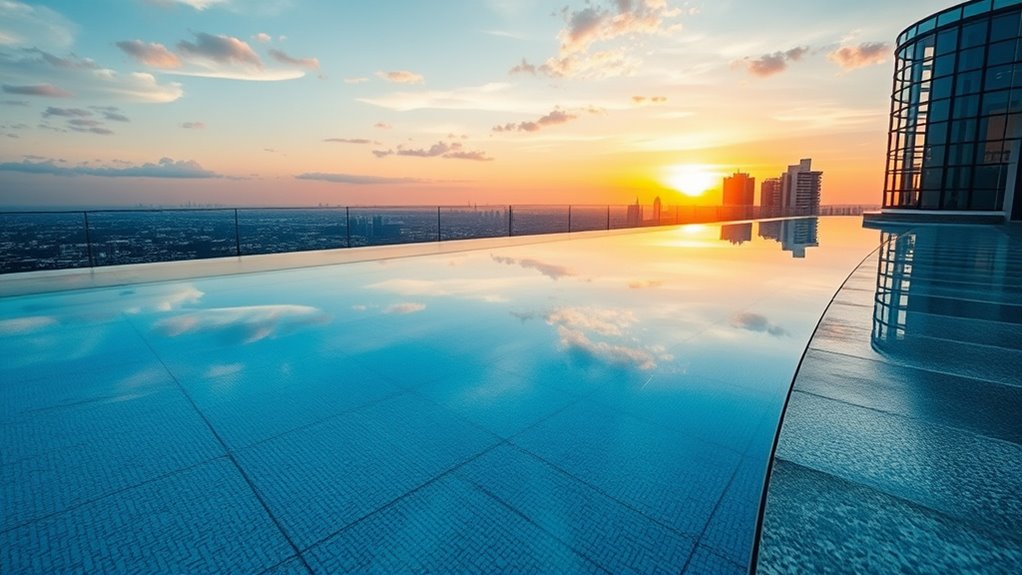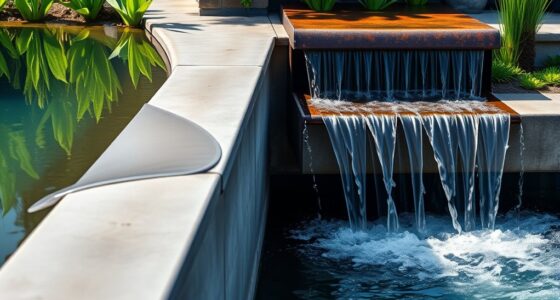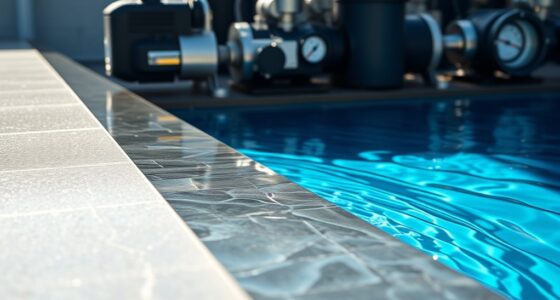When planning a rooftop infinity pool, you must carefully consider structural loads, ensuring your support system can handle water, furniture, and equipment weight. Vibration control is vital to prevent cracks and leaks, especially from wind or foot traffic, by using isolation pads and lightweight materials. Waterproofing with durable, flexible membrane layers and regular maintenance helps avoid leaks and damage over time. Keep exploring to discover detailed strategies for safe, long-lasting rooftop infinity pools.
Key Takeaways
- Ensure rooftop structures can support water weight, equipment, and occupancy through reinforced concrete or steel frameworks.
- Implement vibration mitigation measures like vibration pads and floating slabs to prevent structural stress and damage.
- Design load distribution systems to handle dynamic forces from wind, foot traffic, and equipment movement.
- Use durable waterproofing materials such as PVC, EPDM, and seamless liquid coatings for long-lasting protection.
- Conduct regular inspections and maintenance of waterproofing, supports, and vibration control systems to ensure safety and durability.
Structural Load Considerations for Rooftop Infinity Pools

When planning a rooftop infinity pool, understanding the structural load considerations is crucial to guarantee safety and stability. You need to evaluate the weight of the water, the pool structure, and additional features like furniture or equipment. The building’s existing structure must support these loads without risking collapse or damage. It’s essential to work with structural engineers to analyze load-bearing capacity and identify areas that require reinforcement. Pay attention to dead loads (the weight of the pool itself and fixed components) and live loads (occupants, maintenance, or temporary equipment). Proper load calculations ensure the roof can sustain the weight comfortably, preventing structural failure. Ignoring these considerations can lead to costly repairs or safety hazards, so thorough planning upfront is vital. Additionally, assessing the **load-bearing capacity** of the rooftop helps prevent unexpected structural issues.
Managing Dynamic Loads and Weight Distribution

Effectively managing dynamic loads and weight distribution is essential to guarantee your rooftop infinity pool remains safe and stable during use. You need to account for how people, equipment, and water movement create shifting loads. Distribute weight evenly across the deck by designing a reinforced structure that can handle peak loads without stress points. Use load distribution techniques such as adding support beams or load-bearing walls to prevent localized stress. Regularly monitor the pool’s usage patterns and adjust load management practices accordingly. Be mindful of equipment placement, ensuring heavy machinery is positioned to minimize uneven weight. Properly planning for dynamic loads reduces the risk of structural failure and prolongs the lifespan of your rooftop pool, ensuring safety and performance for every use. Additionally, incorporating noise reduction technology in the surrounding structures can minimize vibrations caused by water movement and equipment operation, further enhancing stability and comfort.
Vibration Control and Its Impact on Pool Integrity

Vibrations can critically affect your rooftop infinity pool’s structural integrity if not properly managed. You need to think about structural load dynamics and implement vibration isolation methods to prevent damage. Over time, unchecked vibrations may compromise durability, so understanding these factors is essential for long-lasting pool performance.
Structural Load Dynamics
Structural load dynamics play a critical role in maintaining the integrity of rooftop infinity pools, especially as vibrations from wind, nearby construction, or foot traffic can transmit through the building’s framework. These dynamic forces cause fluctuating stresses that, if unmanaged, can compromise structural stability or damage the pool. You need to understand how loads distribute across the building, ensuring support systems are properly designed to handle these variations. Sudden shifts or repetitive vibrations may lead to cracks, leaks, or even structural failure over time. Consequently, analyzing load paths and dynamic responses helps identify potential weak points. By accounting for these factors during design and construction, you can prevent excessive movement and preserve the pool’s long-term safety and performance. Additionally, incorporating vibration control measures can significantly reduce the transmission of these forces, safeguarding the structural integrity.
Vibration Isolation Methods
Understanding how to control vibrations is vital for maintaining the integrity of rooftop infinity pools. Excessive vibrations can cause structural stress, crack formation, or waterproofing failures. To prevent these issues, effective vibration isolation methods are indispensable. These include installing vibration pads under equipment, using resilient mounting systems, and incorporating flexible joints in plumbing. Properly designed floating slabs or isolating decks can also absorb vibrations before they reach the pool structure. Additionally, selecting lightweight construction materials reduces overall load and vibration transfer. Being proactive with vibration control preserves your pool’s stability, prevents damage, and ensures long-term performance. Implementing proper insulation techniques can further minimize transmission of vibrations through building structures.
Long-term Durability Effects
Effective vibration control plays a critical role in ensuring the long-term durability of rooftop infinity pools. Unchecked vibrations can cause structural stress, leading to cracks or leaks over time. When vibrations are minimized, you reduce the risk of loosening waterproofing membranes and damaging pool finishes. This preservation of the pool’s structural integrity helps prevent costly repairs and extends its lifespan. Proper vibration management also stabilizes the surrounding deck and support elements, maintaining safety and aesthetic appeal. To optimize durability, you should regularly inspect vibration isolation systems and ensure they function correctly. Incorporating soundproofing techniques can further reduce vibrations transmitted to the pool structure, enhancing its longevity. By controlling vibrations effectively, you protect your investment, ensuring the pool remains safe, functional, and visually appealing for years to come.
Waterproofing Techniques for Elevated Environments

When designing rooftop infinity pools, waterproofing becomes essential to prevent leaks and structural damage, especially since these pools are exposed to the elements at elevated heights. You need reliable, durable solutions that can withstand temperature fluctuations, UV rays, and pooling water. Proper waterproofing guarantees the integrity of both the pool and the building beneath. Here are key techniques to consider:
- Using flexible membrane systems like PVC or EPDM
- Applying liquid-applied waterproof coatings for seamless coverage
- Installing waterproof boards with built-in drainage
- Incorporating multiple protective layers for redundancy
- Ensuring proper detailing around edges and joints
These methods help you create a waterproof barrier, reducing risks of leaks and prolonging your pool’s lifespan in challenging outdoor conditions. Additionally, selecting the right waterproofing method involves understanding the best airless paint sprayer options to ensure even and effective application of waterproof coatings, which is crucial for long-term durability.
Materials and Construction Methods for Longevity

Choosing the right materials and construction methods is key to ensuring your rooftop infinity pool lasts over time. Durable waterproof membranes protect against leaks, while reinforced structural supports handle the weight and stress. Additionally, selecting materials with proper water resistance properties helps prevent deterioration caused by exposure to water and weather conditions. By focusing on these elements, you can build a resilient pool that stands up to the elements and regular use.
Durable Waterproof Membranes
To guarantee your rooftop infinity pool remains watertight over time, selecting durable waterproof membranes is essential. These membranes protect your structure from leaks, water damage, and deterioration. Look for materials that resist UV rays, chemicals, and temperature fluctuations. Reinforced options like PVC, TPO, or EPDM offer flexibility and strength, ensuring longevity. Proper installation is critical—overlaps, sealing, and adhesion must be flawless. Regular inspections and maintenance extend the lifespan of your waterproofing system. Using high-quality membranes not only prevents costly repairs but also enhances safety and durability. Remember, investing in the right materials from the start is key to a resilient, leak-proof infinity pool that stands the test of time. Understanding building requirements and local regulations can help ensure compliance and proper installation.
Reinforced Structural Supports
Reinforced structural supports are essential for ensuring your rooftop infinity pool remains stable and safe over time. You need strong, durable materials like reinforced concrete or steel frameworks to handle the weight of the water, equipment, and occupancy. These supports must be carefully designed to distribute loads evenly, preventing stress concentrations that could cause cracks or failure. Construction methods often include adding rebar or mesh within concrete to enhance tensile strength and rigidity. You should also consider seismic and wind loads specific to your location, ensuring your supports are resilient against these forces. Proper reinforcement not only guarantees safety but also extends the lifespan of your pool by minimizing structural damage and maintenance needs. Prioritize quality materials and precise engineering to secure your investment.
Maintenance and Inspection Strategies to Ensure Safety

Regular maintenance and thorough inspections are essential to keep rooftop infinity pools safe and functioning properly. You should routinely check for signs of wear, leaks, and structural stress. Regularly test the waterproofing layers to prevent water infiltration that can damage supports. Keep an eye on the pool’s load distribution and vibration levels, ensuring they stay within safe limits. Conduct visual inspections of the pool’s edges and surrounding structures for cracks or deterioration. Schedule professional assessments periodically to identify hidden issues early. Additionally, ensure compliance with safety standards and local regulations to prevent accidents and structural failures.
Frequently Asked Questions
How Do Rooftop Pools Affect Building Energy Efficiency?
Rooftop pools can impact your building’s energy efficiency by increasing cooling loads due to the large water surface absorbing heat. You might notice higher energy use for pumps, filtration, and climate control to maintain comfort. Proper insulation and energy-efficient equipment can help mitigate these effects, but you should plan for increased utility costs and guarantee your building’s structure supports the additional load without compromising overall efficiency.
What Are the Best Safety Features for Rooftop Infinity Pools?
You should install sturdy barriers like glass railings to prevent falls and guarantee they’re high enough for safety. Incorporate non-slip surfaces around the pool to avoid accidents, and add proper drainage systems to prevent water pooling. Consider safety alarms and signage to alert users of potential hazards. Regular maintenance and inspections also help keep the pool safe, ensuring all safety features function correctly and you enjoy a secure, relaxing experience.
Can Rooftop Pools Be Integrated With Renewable Energy Systems?
They say, “where there’s a will, there’s a way,” and you can definitely integrate rooftop pools with renewable energy systems. You might install solar panels to power pumps, heating, and lighting, reducing your carbon footprint. Consider solar thermal collectors for water heating or small wind turbines if your location’s windy. With careful planning and professional guidance, you’ll enjoy an eco-friendly oasis that’s both luxurious and sustainable.
How Does Weather Impact Rooftop Infinity Pool Maintenance?
Weather considerably impacts your rooftop infinity pool maintenance. Harsh conditions like heavy rain, strong winds, or freezing temperatures can cause debris buildup, increase wear on waterproofing, and lead to algae growth. You’ll need to regularly clean the water, check for leaks, and adjust chemicals to keep it safe and pristine. Additionally, extreme weather may require you to winterize or cover the pool, preventing damage and reducing maintenance efforts.
What Are Innovative Drainage Solutions for Rooftop Pools?
Imagine rainwater gracefully flowing off your rooftop pool, never pooling or causing damage. You can achieve this with innovative drainage solutions like integrated scuppers that direct water seamlessly to hidden channels, or adjustable slope designs that guarantee efficient runoff. These systems prevent water buildup, reduce structural stress, and maintain your pool’s pristine appearance, giving you peace of mind while enjoying the stunning skyline view.
Conclusion
Think of your rooftop infinity pool as a delicate sailboat on a vast sea. With proper load management and waterproofing, you navigate safely through the waves of vibration and weight. Regular inspections act as your vigilant crew, keeping everything steady and secure. When you respect these elements, your pool becomes a serene oasis, effortlessly floating above the cityscape, inviting relaxation without worry—truly a masterpiece of engineering and design.









